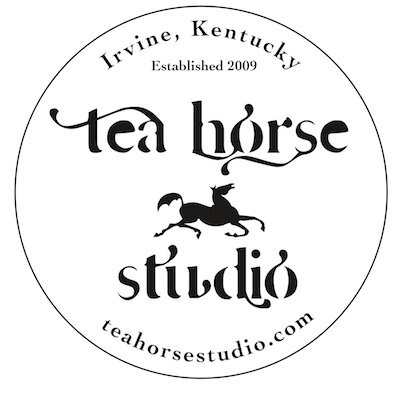Eat Me
Yummy colors. A good color is an exciting thing. Does anyone else collect paint chips from the hardware store just to have them and play with combinations? Most of the time because of the drawing I've done, my work has relied on a basic palette of colored slips glazed in a clear glaze but I do love a meaty, colorful glaze. Working with a matte texture and tiny crystalline effects adds to that happiness.
Coloring glazes is done through incremental additions of naturally occurring oxides and carbonates or manufactured stains to a base glaze. Common oxides and carbonates that provide a color response in a glaze fall in the transition metals area of the periodic table and include nickel, copper, cobalt, iron, manganese, chrome and opacifiers such as tin and zirconium.
For more controlled color, manufactured stains called frits are used, where companies essentially create the color using their proprietary recipe of oxides and carbonates in a glaze (amorphous glass structure) then crush it into a fine powder. I use both the natural materials and the manufactured materials, depending on what color I'm trying to achieve.
The same red iron oxide/copper carbonate combination in a strontium flux base, a barium flux base, a magnesium flux base and a zinc flux base.
For the most part, oxides are used in tiny amounts relative to the fluxes, feldspars and silica in a glaze. The type of alkaline earth flux used in a glaze recipe can change the color response of any one oxide. For the most part, calcium fluxes like whiting (calcium carbonate) provide the most predictable color response but when you move to fluxes like zinc oxide and magnesium oxide, suddenly, you can find your chrome green turning pink (or from an antique green to brown in my case). The other thing that can affect color response is the method used to fire your work. I fire in an electric kiln so oxidation is the method I use, meaning the air surrounding the work is heated up using electric resistance – kind of like an electric heater but bigger. I also sometimes use what's referred to as atmospheric firing, meaning the temperature is raised using a combustable fuel such as wood or gas or oil. This atmosphere can be manipulated via means of reducing the amount of oxygen and creating different chemical reactions with the oxides in the glaze during the firing. The wood/soda firings I do with Bobtown Arts in Berea use these types of kilns.
For the most part, small additions of colorants don't always affect the performance of the glaze but there are some exceptions if your proportion of colorant is larger. The most prominent examples of this are iron oxides and chrome oxides, something I'll explore more in the future, I think, after I finish the CMW Advancing Glazes course I'm in now.
So let's look at some colors in the base matte of the Strontium Chinese Bronze glaze I started with when I swap out the original additives of copper carbonate and red iron oxide for new combinations!
If you read horizontally and vertically, you can see the kinds of colors you can get with various percentage combinations of colorants. This last lab was a huge lab in the Understanding Glazes course from Ceramic Materials Workshop and I really had to concentrate on each combination mixed. One of those crack-your-knuckles tasks. Still, it has that “wow” factor even though my glaze crawled and flashed all over my test tiles.
Now all I have to do is figure out HOW to use these possibilities! Next up, exploring a clay body of my own and delving further into my base glaze.




